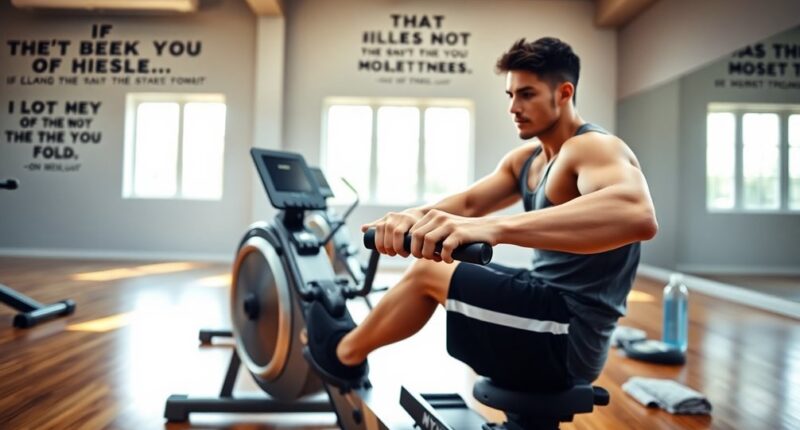To maximize your rowing machine workout, start by ensuring proper form and adjusting your seat and footrests for ideal alignment. Engage your core and adjust resistance levels to challenge different muscle groups. Create a structured routine that includes interval training and steady-state sessions while monitoring progress through key metrics. Remember to incorporate recovery days for muscle repair. For more expert strategies on enhancing your performance, keep exploring effective workout techniques and tips.
Key Takeaways
- Adjust your seat and footrests for proper alignment, ensuring optimal stroke efficiency and body posture during workouts.
- Vary resistance levels to target different muscle groups and prevent workout plateaus, enhancing both strength and cardiovascular fitness.
- Incorporate a structured routine with steady-state rowing, interval training, and strength circuits to meet your fitness goals effectively.
- Maintain a neutral spine and engaged core to maximize power output and reduce the risk of injuries during rowing sessions.
- Track your progress through metrics like stroke rate and split time while ensuring rest and recovery for muscle repair.
Understanding the Rowing Machine Mechanics
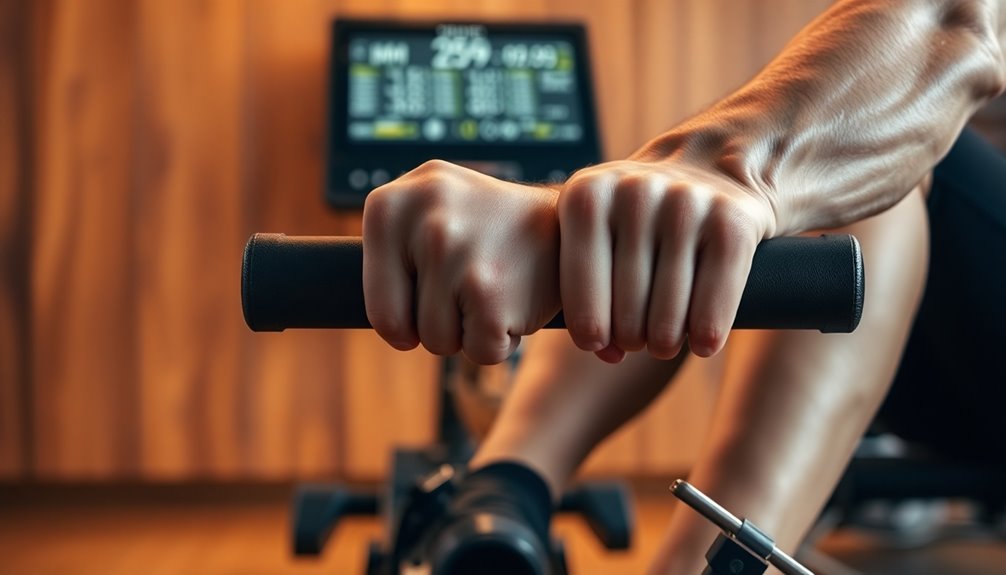
When you step onto a rowing machine, understanding its mechanics is vital for an effective workout. Start by adjusting the seat and footrests to guarantee proper foot placement, which is essential for achieving correct hip alignment. This enhances leg engagement and maximizes the efficiency of each rowing stroke.
Focus on your rowing technique, beginning from a neutral spine position with relaxed shoulders to avoid posture errors. The rowing motion consists of three phases: the catch position, drive, and return. Each phase requires a specific sequence to boost endurance and power output.
Remember to maintain core engagement throughout the rowing motion; this not only maximizes your power but also prevents discomfort, contributing to a sustainable and effective workout.
Importance of Proper Form and Technique
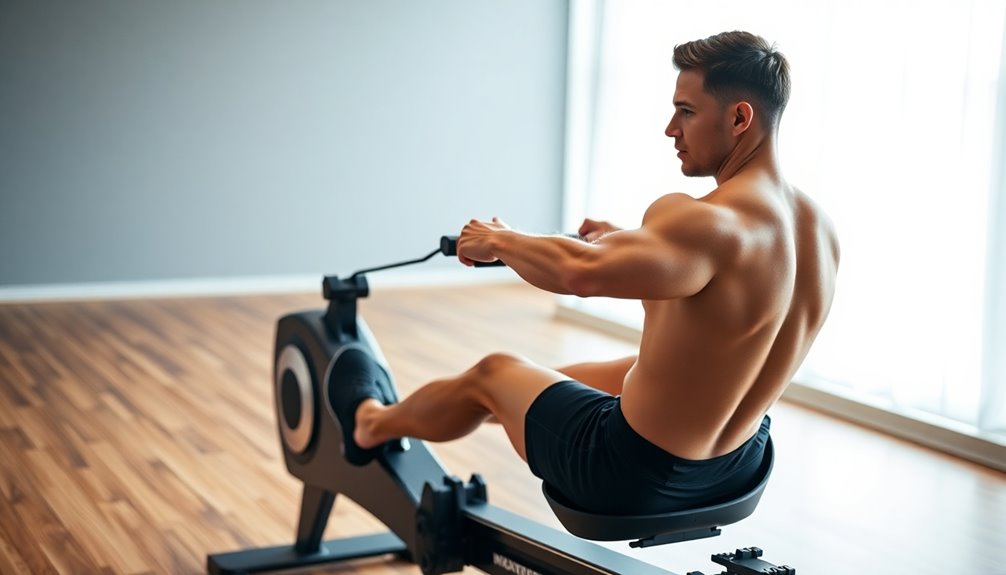
Proper form and technique are fundamental to maximizing the benefits of your rowing machine workout. By focusing on your posture, you'll enhance your performance and guarantee injury prevention.
Here are three key aspects to remember:
- Maintain Body Alignment: Keep a neutral spine and relaxed shoulders to support effective power generation.
- Engage Core Muscles: Activating your core throughout the stroke enhances stability and contributes to fluid motion.
- Avoid Posture Errors: Stay aware of common mistakes like leaning back too far or hunching your shoulders, which can hinder maximizing power output.
Adjusting Resistance Levels for Optimal Performance
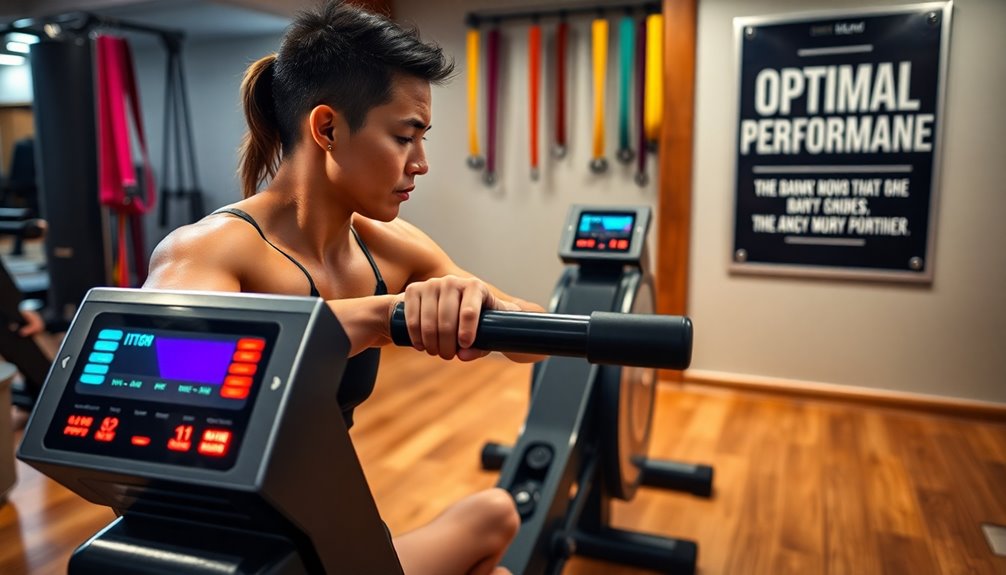
To achieve ideal performance on your rowing machine, adjusting resistance levels is crucial. By tailoring workout intensity, you can effectively target different muscle groups, enhancing overall strength and endurance.
Higher resistance simulates rough water conditions, engaging more muscle fibers during each stroke, while lower resistance allows you to focus on technique and stroke rate for better form.
Regularly changing resistance settings prevents workout plateaus, encouraging continuous improvement as your strength increases. Gradually raising resistance over time guarantees consistent progress and minimizes the risk of injury from sudden intensity changes.
Incorporating these adjustments into your routine will lead to a more effective and rewarding rowing experience.
Creating an Effective Rowing Workout Routine

Creating an effective rowing workout routine starts with establishing clear fitness goals, which guide your training and keep you motivated. To maximize your results, consider the following steps:
- Develop a structured training schedule that includes a mix of steady-state rowing, interval training, and strength circuits to target different muscle groups effectively.
- Warm up properly before each session and cool down afterward to prepare your body for exercise and promote recovery.
- Track key metrics like stroke rate, split time, and total distance to monitor your progress and adjust your plan as needed.
Don't forget to include recovery days to allow for muscle repair, ensuring sustainable growth and improved performance. Additionally, incorporating intelligent control systems in your training can help optimize energy usage based on your workout demands.
Stick to these strategies for effective rowing workouts!
Integrating Interval Training for Enhanced Results
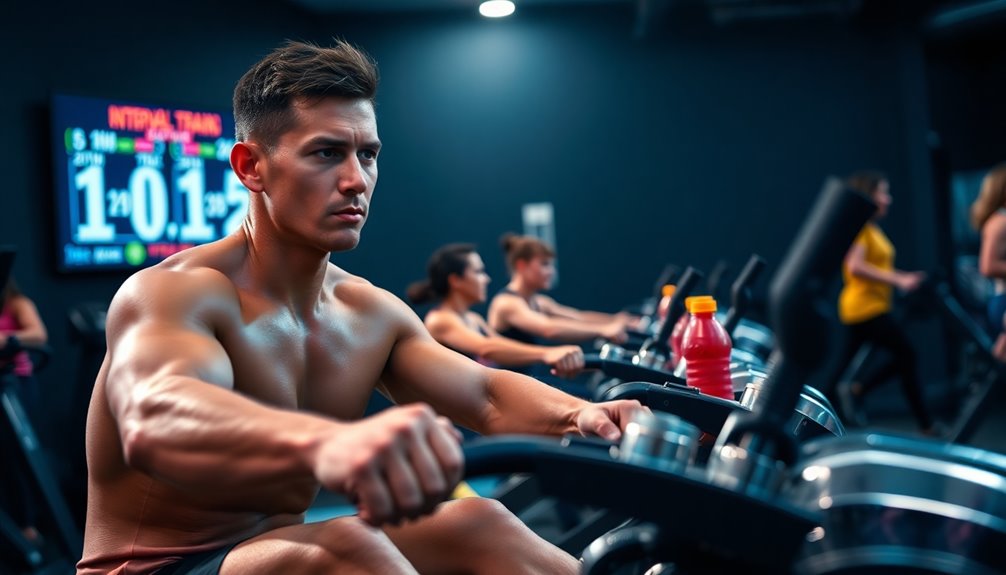
Integrating interval training into your rowing routine can greatly boost your results.
By implementing techniques like HIIT or Tabata sprints, you'll enhance your cardiovascular endurance and optimize your performance.
Plus, tracking your progress will keep you motivated and help you achieve your fitness goals faster.
Benefits of Interval Training
While many rowing workouts stick to steady paces, incorporating interval training can dramatically elevate your fitness results.
By alternating high-intensity bursts with lower-intensity recovery, you'll enhance your cardiovascular endurance and aerobic capacity.
Here are three key benefits of interval training:
- Increased Calorie Burn: Research shows you can burn up to 15% more calories compared to steady-state workouts.
- Improved Power Output: Engaging different muscle groups during high-intensity interval training (HIIT) boosts your overall performance.
- Faster Recovery: Interval training trains your body to recover quickly, which is essential for enhancing athletic performance.
Incorporating these techniques into your rowing routine will help you maximize results and achieve your fitness goals faster.
Implementing HIIT Techniques
To get the most out of your rowing machine workouts, consider implementing High-Intensity Interval Training (HIIT) techniques. By alternating between short bursts of maximum effort—lasting 20-60 seconds—and recovery periods of lower intensity, you'll enhance your cardiovascular fitness and calorie burn.
For instance, try 1 minute of all-out rowing followed by 2 minutes of easy rowing. This method boosts oxygen utilization and greatly improves stamina and strength.
HIIT sessions can effectively increase your performance gains in just 20-30 minutes, making your workouts more efficient.
Don't forget to focus on tracking metrics like stroke rate and split times to guarantee you're adjusting the intensity appropriately for ideal results.
Monitoring Your Progress
Monitoring your progress is essential when you incorporate interval training into your rowing workouts, as it helps you stay focused and motivated.
By tracking progress, you'll enhance your workout effectiveness and maximize your time. Here are three key metrics to monitor:
- Stroke Rate: Keep an eye on your strokes per minute to gauge intensity.
- Split Time: Measure how long it takes to complete a set distance, helping you assess speed improvements.
- Endurance and Stamina: Track how long you can maintain high-intensity intervals over time.
Using performance feedback allows you to adjust your workouts, ensuring continuous progress.
As you refine your strategy, you'll build endurance and stamina, ultimately leading to greater results from your rowing sessions.
Common Rowing Mistakes to Avoid
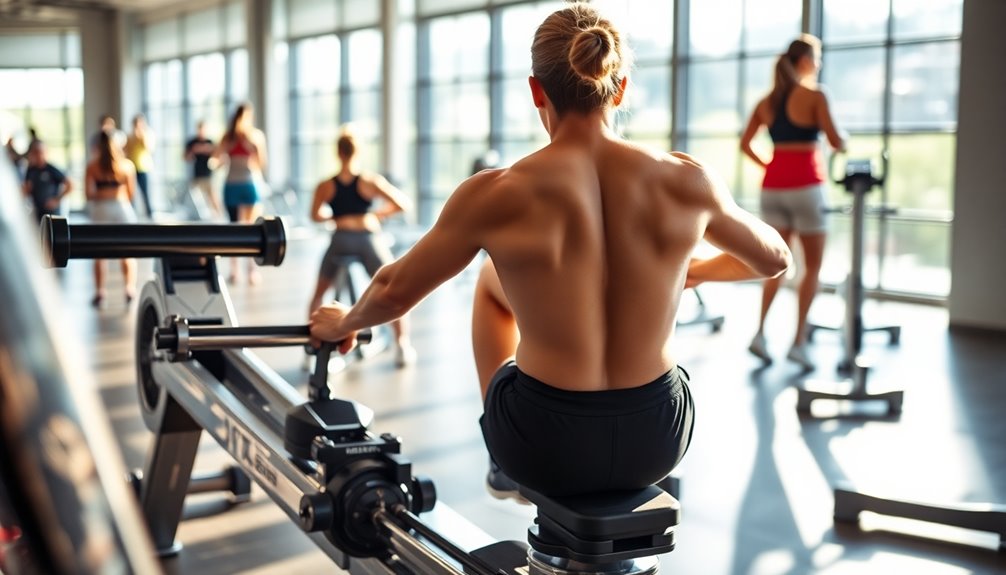
When you're rowing, it's essential to focus on your posture and alignment to prevent strain and maximize efficiency.
Improper foot placement can throw off your balance, while neglecting resistance levels might limit your workout's effectiveness.
Let's explore these common mistakes so you can get the most out of your rowing sessions.
Posture and Alignment Errors
- Hunching Over: This disrupts your alignment and can strain your lower back. Keep a neutral spine and relaxed shoulders.
- Weak Core Engagement: Failing to engage your core reduces power generation and increases strain on your back and shoulders.
- Over-Gripping the Handle: A tight grip creates tension in your arms and shoulders, diminishing muscle activation and workout effectiveness.
Focus on maintaining proper form, ensuring correct foot placement, and relaxing your grip to enhance your rowing experience and achieve better results. Additionally, cultivating a growth mindset can significantly improve your ability to learn and adapt your technique over time.
Improper Foot Placement
Proper foot placement on the rowing machine is vital for maximizing your workout efficiency and minimizing injury risk. It guarantees optimal hip alignment, which is essential for engaging your legs effectively during each stroke, enhancing power generation.
If your feet are positioned inadequately, you'll face inefficient strokes and an increased risk of injury, particularly in your knees and lower back. Properly positioning your feet allows for a natural range of motion, promoting effective leg drive while preventing reliance on your arms.
Make certain your straps are snug but not overly tight to maintain foot stability. Regularly check your foot placement to reinforce proper technique; even slight misalignments can accumulate, leading to decreased performance and discomfort over time.
Neglecting Resistance Levels
Neglecting to adjust resistance levels on your rowing machine can considerably undermine your workout's effectiveness.
Proper resistance is essential for enhancing muscle engagement and optimizing your results. Here are three key reasons to adjust resistance:
- Boosts Calorie Burn: Higher resistance increases the effort needed, maximizing calorie expenditure.
- Encourages Strength Gains: Adjusting resistance promotes muscle adaptation, helping you build strength over time.
- Improves Cardiovascular Fitness: Varying resistance levels maintains workout intensity, enhancing your overall fitness. Additionally, maintaining strong encryption standards during your workouts can help protect your personal data, especially if you're tracking fitness metrics online.
Monitoring Progress and Performance Metrics
How can you truly gauge your rowing performance if you're not tracking your progress? Monitoring progress through key performance metrics is vital for improving your workouts.
Focus on your stroke rate, as it helps assess your efficiency and adjust your pacing during rowing sessions. Keep an eye on your split time—this measures how long it takes to row 500 meters, important for evaluating speed improvements and setting personal bests.
Logging total duration and workout intensity fosters accountability, offering insights into how you can tweak your training. Using a consistent method and the same rowing machine guarantees accurate comparisons over time.
Building Endurance and Strength With Rowing
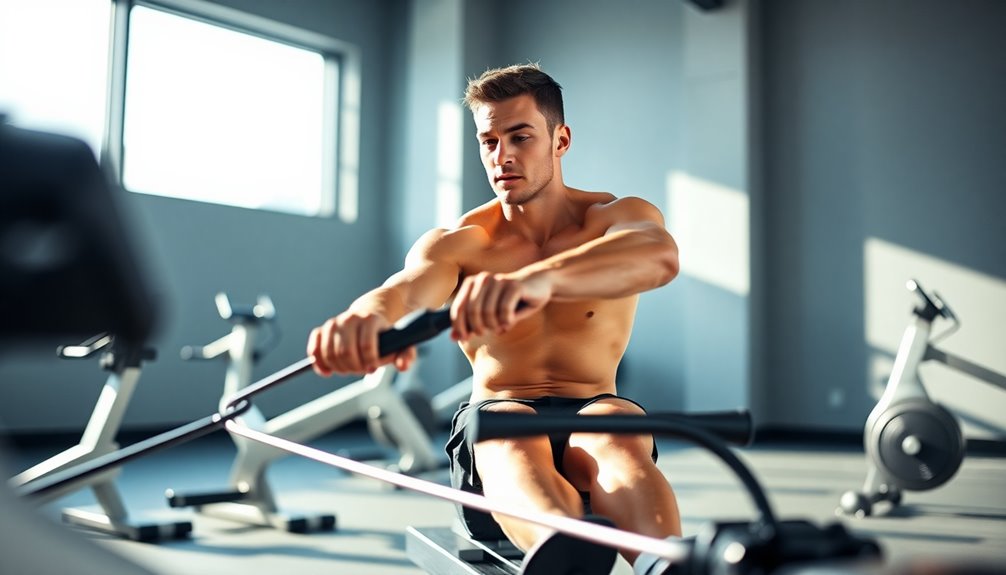
To build endurance and strength with rowing, you should mix different training styles.
Incorporating steady-state rowing, high-intensity interval training (HIIT), and strength exercises can maximize your results.
Mixing Strength Training
Integrating strength training into your rowing workouts not only boosts muscle growth but also enhances your endurance, leading to improved performance on the machine.
By mixing strength training, you can effectively target major muscle groups while building endurance. Here are a few tips to maximize your results:
- Incorporate intervals: Alternate between rowing and strength exercises, like dumbbell lunges or push-ups.
- Focus on proper form: Maintaining good form during both rowing and strength exercises helps prevent injuries and promotes efficiency.
- Prioritize recovery intervals: Allow for recovery days to let your muscles repair and grow, essential for overall fitness.
This balanced approach to cardiovascular exercise and strength training will greatly enhance your rowing performance. Additionally, incorporating recovery intervals is crucial for muscle repair, which can lead to improved results in both rowing and strength training.
Steady-State Rowing Benefits
While many workouts focus on high intensity, steady-state rowing offers unique benefits that can greatly boost your endurance and strength. By maintaining a consistent stroke rate, you enhance your cardiovascular endurance over longer durations, which is essential for overall fitness.
This approach not only helps you burn more calories compared to shorter sessions, but it also improves the efficiency of your heart, lungs, and circulatory system.
Additionally, steady-state rowing strengthens major muscle groups—especially in your legs and core—contributing to muscle strength and endurance.
Incorporating this into your regular workout routine builds a strong aerobic base, leading to significant performance improvements and preparing you for more intense training in the future.
HIIT for Endurance
Building on the endurance gains from steady-state rowing, incorporating High-Intensity Interval Training (HIIT) can take your workouts to the next level. This method alternates intense rowing bursts with recovery, effectively boosting your cardiovascular endurance and overall rowing performance.
Here's how to maximize your HIIT sessions:
- Short Bursts: Aim for 20-60 seconds of all-out effort to enhance your anaerobic capacity and stroke rate.
- Active Recovery: Follow each intense interval with 30 seconds of active recovery, allowing your body to recover while still engaging muscles.
- Consistency: Regularly integrate HIIT into your routine to improve oxygen utilization, burn more calories, and build both aerobic and anaerobic endurance efficiently.
Embrace HIIT, and watch your strength and endurance soar!
Recovery Strategies to Enhance Performance
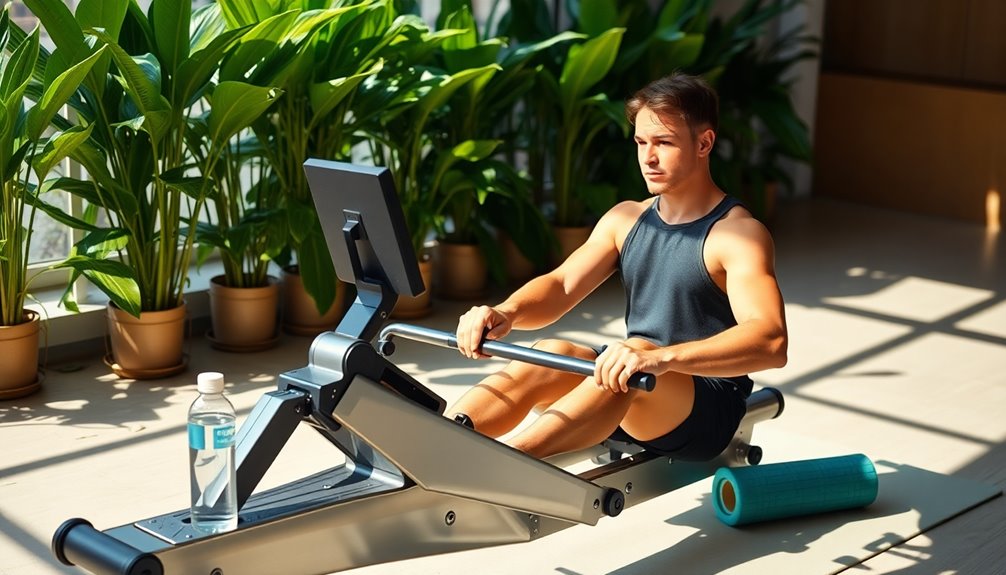
To enhance your performance on the rowing machine, effective recovery strategies are vital for optimizing your workouts. Incorporate rest days into your training plan to allow for muscle recovery; your muscles need time to repair and grow stronger.
Engage in active recovery activities like light walking or yoga to reduce muscle soreness and boost flexibility without additional strain. After rowing, focus on protein intake by consuming 10-20 grams within 30 minutes to aid muscle repair.
Hydration is essential, so drink water before, during, and after your workouts to prevent dehydration and support performance enhancement.
Finally, utilize stretching techniques, especially static stretches for major muscle groups, to improve flexibility and promote injury prevention.
Tips for Staying Motivated and Consistent
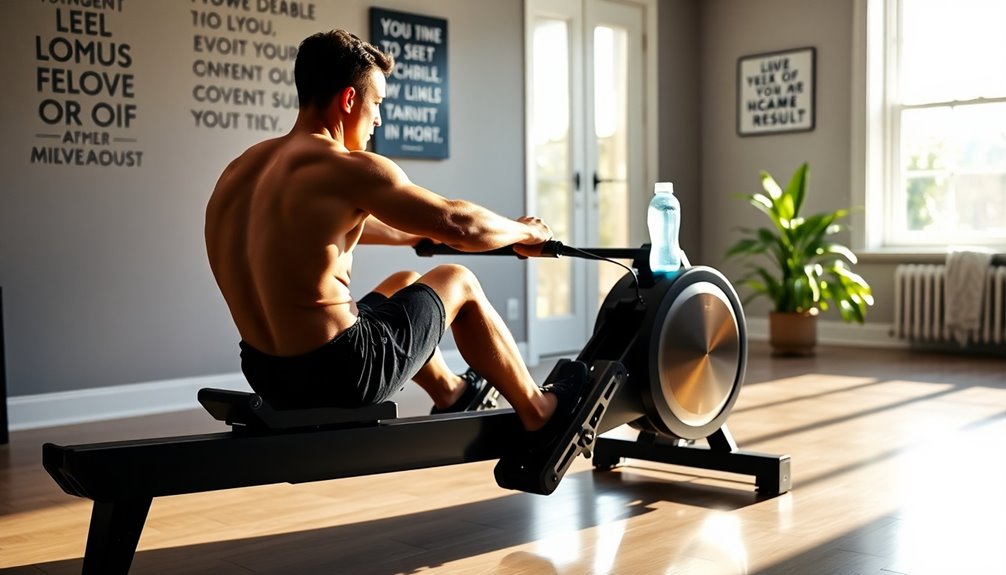
Staying motivated and consistent with your rowing machine workouts is essential for achieving your fitness goals. Here are some tips to help you stay on track:
- Set Clear Goals: Define specific, achievable fitness objectives to give your workouts direction and boost your motivation and commitment.
- Track Progress: Use metrics like stroke rate and split times to visualize improvements, fostering accountability.
- Incorporate Variety: Mix steady-state rowing with high-intensity interval training to keep your routine fresh and engaging.
Additionally, establish a structured training schedule that includes rest days to prevent burnout.
Joining a rowing community or finding a workout buddy can enhance your experience, providing social support and friendly competition to keep you engaged and motivated.
Frequently Asked Questions
How to Get the Most Out of a Rowing Machine Workout?
To get the most out of your rowing machine workout, focus on maintaining proper form with a neutral spine and engaged core.
Incorporate high-intensity intervals to boost your cardiovascular fitness, and track your progress by documenting metrics like stroke rate and distance.
Mix up your routine with steady-state rowing and power strokes to target different muscles.
Don't forget to warm up and cool down to prepare your body and aid recovery!
Is 20 Minutes of Rowing a Day Enough?
Yes, 20 minutes of rowing a day can be enough to see significant benefits.
This duration can improve your cardiovascular fitness, boost endurance, and enhance muscle strength, especially in your legs and core.
If you incorporate interval training, you'll maximize calorie burn and fat loss.
Just remember, consistency is key.
To get the most out of your workouts, consider pairing rowing with strength training and allowing for proper recovery days.
How Do I Maximize My Rowing Machine Distance?
To maximize your rowing machine distance, focus on maintaining a steady pace for 20-30 minutes to build endurance.
Incorporate interval training by adding short bursts of high-intensity rowing, followed by recovery periods.
Keep track of your split time to monitor progress and aim for faster splits.
Make sure your form is correct, engaging your legs during the drive phase, and adjust the resistance to challenge yourself and simulate different rowing conditions.
What Is the Most Efficient Technique for Rowing Machine?
Think of rowing like a dance; every move must flow seamlessly.
To maximize efficiency on the rowing machine, start with a neutral spine and relaxed shoulders. Engage your core and push with your legs first, then lean back slightly and pull with your arms.
Keep your feet properly placed for effective leg work, and maintain a balanced stroke rate. Gradually increase intensity while ensuring each phase of your stroke connects smoothly for peak performance.
Conclusion
Incorporating these expert tips into your rowing routine can transform your workouts from mundane to exhilarating. While proper form and technique lay the foundation for success, adjusting resistance levels and integrating interval training can push your limits further. As you monitor your progress, you'll see endurance and strength grow, fueling your motivation. Balancing hard work with effective recovery strategies will keep you on track, ensuring you row not just for fitness, but for the joy of every stroke.
